|
Masai Mara Game Reserve, Kenya The Mara River July 2000 |
||
| (Click any photo throughout to see a larger version) | ||
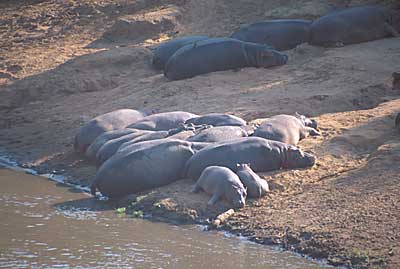
|
||
| A Busy Afternoon at the Mara River | ||
|
The most spectacular goings-on in the Masai Mara were not the
big cats, but rather the drama of the annual migration, complete with the treacherous
river crossings you see depicted so vividly on National Geographic television specials.
A typical morning by the Mara river isn't so dramatic though. It's more like this. Tons and tons of blubbery mammals lounging around, waiting for the cool of evening. | ||
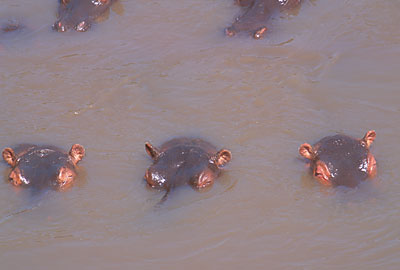
|
||
| Synchronized Hippos | ||
| Large hippo piles on the riverside are the exception, actually. Most hippos spend all day lounging in the river itself. This set appears to be practicing for their synchronized swimming debut at the Olympics. | ||
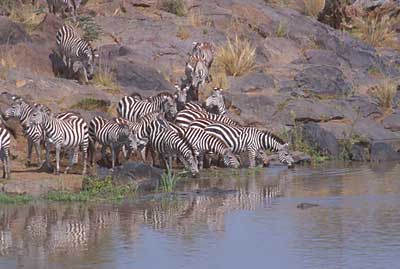
|
||
| Zebra Waiting On Far Shore | ||
| Our guide Albanus took us to one of the most commonly used crossing sites along the Mara river. This herd of zebra were already on the far side, having crossed earlier. As they took turns drinking, they seemed to be waiting for some activity on our side. Our guide Albanus noticed that on our side of the river, a large herd of wildebeest were meandering our way. We settled in to watch the drama unfold. | ||
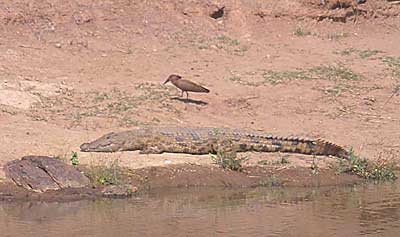
|
||
| Danger Lurking | ||
| Meanwhile, on the bank of the river just a few hundred feet from the zebra herd, this Nile crocodile waited ominously. In truth, this was a pretty small Nile crocodile, not large or strong enough to pose any real threat to zebra or wildebeest. Still, it looked pretty ominous, and we were glad it was there to liven up the story. The funny-looking bird uncautiously strolling by is a hammerkop. | ||
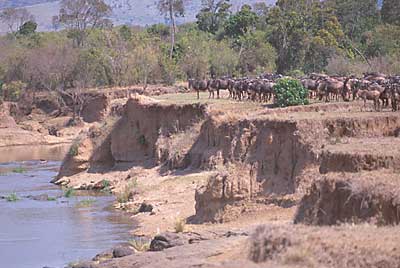
|
||
| Wildebeest Pondering | ||
|
The meandering wildebeest finally did make it over to the top of the cliffs at the
river's edge. None of them seemed to want to take the initiative of figuring out
how to actually cross the river though. Albanus told us that wildebeest are in fact
really stupid and incapable of making complicated decisions like how to cross the
river by themselves. They require the assistance of zebras, who do all the actual
planning and leading by example.
After about half an hour of watching wildebeest mingle aimlessly, we were beginning to consider abandoning this scene for lunch back at the camp. However, just in the nick of time, a group of 7 or 8 zebra began striding purposefully in this direction. | ||
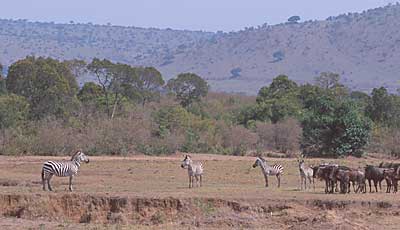
|
||
| Commander Zebra Addressing His Troops | ||
| When at last the zebra arrived, the head zebra took charge immediately. "You guys stay here and watch for lions and such," he no doubt told his zebra comrades-in-arms, "and I'll go down there and check out the river situation. Private Stripes, you come with me." | ||
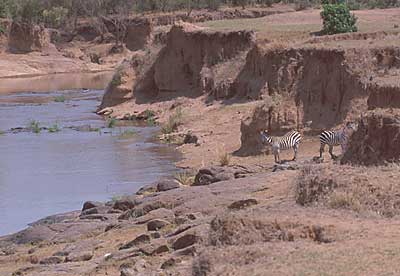
|
||
| Commander Zebra Testing Water | ||
|
So Commander Zebra and his trusty assistant Private Stripes followed a path down the cliff
to the riverside. There they called across to the zebras on the other side, who called back
(really! I am not making this up!). Commander Zebra carefully lowered his head to the river
and took a long drink. We were very excited, watching this. Soon we would get to see the
famous migration across the river!
But it was not to be. Something in the water tasted wrong to Commander Zebra, and he and the private climbed back up the cliffs and started browsing on nearby foliage rather than leading the troops across. And you can bet those wildebeest weren't going to figure out how to get across by themselves. After another twenty minutes or so watching the gradually dispersing herds, we gave up and headed back for lunch. We never did get to see any animals actually cross the river. | ||

|
||
| Onward to Tanzania | ||
| The next day we explored the far side of the river. We saw thousands of wildebeest moving in the general direction of Tanzania. Perhaps some of these were the same wildebeest we had seen not crossing the river the previous day. | ||
| On that note, I'll draw this account of our African adventure to a close. I hope it took you less time to look through it than it took me to finish writing it. | ||
|
John Sullivan March 26, 2001 | ||
| Return to Uganda and Kenya Trip Overview | ||